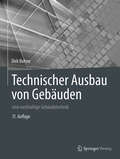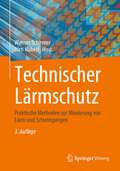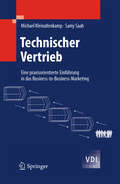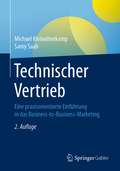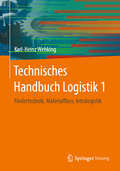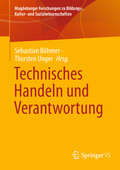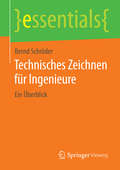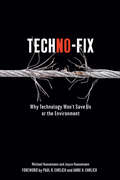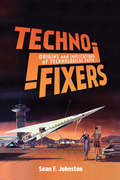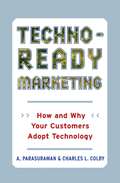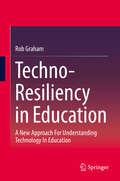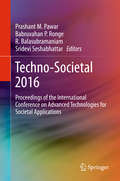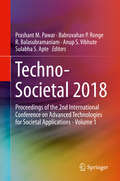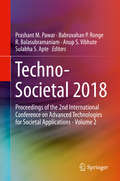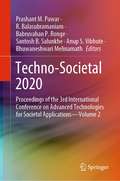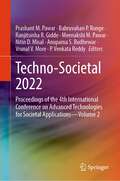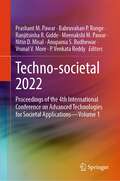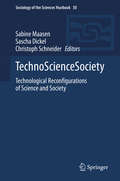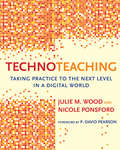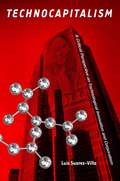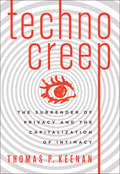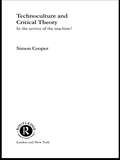- Table View
- List View
Technischer Ausbau von Gebäuden: und nachhaltige Gebäudetechnik
by Dirk BohneAuf dem neuesten “Stand der Technik” präsentiert sich das Buch noch übersichtlicher mit einer neu gegliederten, äußerst benutzerfreundlichen Darbietung des Stoffes. Das Fachwissen wurde dabei konzentriert und komprimiert auf die für Architekten und Bauingenieure relevanten Sachverhalte und Zusammenhänge. Komplett neu gestaltet wurde der umfangreiche Abbildungsteil mit hochwertigen Zeichnungen zur bildhaften Kommentierung des Textes. Um im Technischen Ausbau mit der technologischen Entwicklung, den steigenden Komfortansprüchen und den Erfordernissen eines wirtschaftlichen und umweltfreundlichen Umgangs mit der Energie Schritt zu halten, ist der “Wellpott/ Bohne” weiterhin ein unverzichtbares Grundlagenbuch.
Technischer Lärmschutz: Praktische Methoden zur Minderung von Lärm und Schwingungen
by Werner Schirmer Jörn HübeltDieses Fachbuch behandelt Themen des technischen Lärmschutzes und den eng mit ihm verbundenen Schwingungsschutz. Es enthält physikalische Erläuterungen, Bemessungs-, Mess- und Bewertungsmethoden, umfangreiche Literatur- und Normenzitate und ist mit zahlreichen Bildern und Tabellen ausgestattet. Die Darstellungsweise orientiert sich an kompakten Fortbildungsveranstaltungen für Ingenieure. Für diese Neuauflage wurde das zuletzt 2006 erschienene Fachbuch - insbesondere in den Bereichen der Messtechnik und der Schalldämpferauslegung - umfangreich aktualisiert, wobei die ursprüngliche Konzeption beibehalten wurde. Es ist geeignet sowohl für die tägliche Arbeit von Ingenieuren als auch für das Studium und die individuelle Wissenserweiterung.
Technischer Vertrieb
by Michael Kleinaltenkamp Samy SaabDas Buch liefert eine praxisorientierte Einführung in das Gebiet des technischen Vertriebs bzw. Business-to-Business-Marketings. Die Autoren behandeln alle relevanten Themen des Fachs und stellen die wichtigsten Konzepte und Methoden vor. Ziel ist es, Praktikern und Studierenden mit ingenieurswissenschaftlichem oder einem anderen nicht-kaufmännischen Hintergrund einen schnellen Einstieg und zugleich umfassenden Überblick zu dem Thema zu ermöglichen.
Technischer Vertrieb: Eine praxisorientierte Einführung in das Business-to-Business-Marketing
by Michael Kleinaltenkamp Samy SaabDas Buch liefert eine praxisorientierte Einführung in das Gebiet des technischen Vertriebs bzw. Business-to-Business-Marketings. Die Autoren behandeln alle relevanten Themen des Fachs und stellen die wichtigsten Konzepte und Methoden vor. Ziel ist es, Praktikern und Studierenden mit ingenieurswissenschaftlichem oder einem anderen nicht-kaufmännischen Hintergrund einen schnellen Einstieg und zugleich umfassenden Überblick zu dem Thema zu ermöglichen.
Technisches Handbuch Logistik 1: Fördertechnik, Materialfluss, Intralogistik
by Karl-Heinz WehkingDieses zweibändige Handbuch vermittelt die systemtechnischen Grundlagen und den technischen Entwicklungsstand der Bereiche Materialfluss und Logistik.Der erste Band behandelt zunächst die Bereiche der Entwicklung und Eingrenzung von Fördertechnik, Materialflusstechnik, Intralogistik und technischer Logistik. Diese beinhalten die Beschaffungs-, Produktions-, Distributions- und Entsorgungslogistik. Eingegangen wird ebenfalls auf die wirtschaftliche und volkswirtschaftliche Bedeutung der Logistik.Daran anschließend werden die Bauelemente der Logistik nach den Konstruktionselementen der Fördertechnik (Seile, Ketten, Bremsen etc.) vorgestellt sowie auf die Antriebstechnik und Ölhydraulik eingegangen. Ein weiteres Kernthema dieses Abschnitts sind die Konstruktionselemente der Elektrotechnik, d. h. der Sensorik, Aktorik, Steuerungs- und Regelungstechnik. Mit beiden Komponenten lassen sich die maschinenbaulichen Konstruktion und die Automatisierung der Maschinen und Einrichtungen der Logistik realisieren. Abschließend wird die Systematik der Materialflussaufgaben, hauptsächlich für die Stückgüter, umfangreich dargestellt. Es wird auf Verpackungstechnik und Ladeeinheitenbildung, Lagertechnik, Fördertechnik (Stetig- und Unstetigförderer), Sortier- und Kommissioniertechnik, Verkehrstechnik, Handhabungstechnik und Weiteres eingegangen.
Technisches Handbuch Logistik 2: Fördertechnik, Materialfluss, Intralogistik
by Karl-Heinz WehkingDieses zweibändige Handbuch vermittelt die systemtechnischen Grundlagen und den technischen Entwicklungsstand der Bereiche Materialfluss und Logistik. Der zweite Band beginnt mit einer systematischen und umfassenden Darstellung der heutigen Informations- und Steuerungssysteme der Logistik sowie deren zukünftige Weiterentwicklung. Heutige Systeme der Materialflusstechnik und Logistik sind ohne digitale Informations- und Steuerungssysteme nicht vorstellbar und optimierungsfähig. In diesem Zusammenhang werden beispielsweise ERP-Systeme, Warehouse Management Systeme (WMS), Warehouse Control Systeme (WCS), Transportmanagementsysteme (TMS) und Weiteres. behandelt. Daran schließt sich das Thema rechnergestützte Planungstechniken mit den Teilgebieten Aufgaben der Planung, Vorgehensweise, Simulation und Expertensysteme an. Am Ende dieses Teilkapitels werden Forschungsergebnisse des IFT zur Weiterentwicklung im Bereich der EDV-gestützten Planung vorgestellt. Abschließend wird an zwei Projektbeispielen die heutige moderne und hochautomatisierte Einrichtung der Distributions- und zukünftigen Automobilproduktionslogistik gezeigt (Forschungsprojekt des IFT ARENA2036). Bei letzterem geht es um die flexible wandlungsfähige Automobilproduktion für die Stückzahl 1.
Technisches Handeln und Verantwortung (Magdeburger Forschungen zu Bildungs-, Kultur- und Sozialwissenschaften)
by Thorsten Unger Sebastian BöhmerWir sind daran gewöhnt, dass technische Bauten, Apparate und Anlagen funktionieren. Erst wenn Probleme auftreten, erfahren sie Aufmerksamkeit – und es wird die Frage nach der Verantwortung gestellt, oft an die beteiligten Ingenieure. Besonders intensiv wird diese Frage bei heiklen Hochtechnologien wie Atom- und Gentechnik oder sensiblen Infrastrukturen wie Brücken-, Kanal- und Tunnelbauten diskutiert. Im Katastrophenfall vermischen sich dann häufig juristische, sozio- und psychologische, wirtschaftliche, ethische, religiöse und ingenieurwissenschaftliche Aspekte, was sich auch für die Darstellung dieser Problematik in der Kultur seit dem Ausgang des 19. Jahrhunderts beobachten lässt. Der Band versammelt Beiträge von Expertinnen und Experten aus den Fachgebieten Maschinenbau, Technikphilosophie, Technikgeschichte, Moraltheologie, Berufs- und Betriebspädagogik, Literaturwissenschaft und Linguistik. Sie stellen theoretische wie praktische Aspekte von Verantwortung in der Ingenieurstätigkeit sowie entsprechende Diskurse in Politik, Kultur und Gesellschaft vor. Die Beiträge gehen zurück auf eine Ringvorlesung für Studierende aller Fakultäten im Sommersemester 2023 an der Otto-von-Guericke-Universität Magdeburg.
Technisches Zeichnen für Ingenieure: Ein Überblick (essentials)
by Bernd SchröderMaschinenbauliche und bautechnische Zeichnungen legen die zu erstellenden Objekte fest. Um diese Zeichnungen eindeutig zu gestalten, wurde ein umfangreiches Normenwerk etabliert, in welchem Grundnormen und Zeichnungsarten vereinbart sind. Formate, Maßstäbe und Ansichten werden vorgestellt, ebenso wie Linien und Darstellungen (Linienarten, Buchstaben, Ziffern und Schrift). Schraffur und Bemaßung sind ebenfalls aufgeführt. Für bautechnische Zeichnungen wird die Darstellung von Baumaterialien gezeigt, aber auch Bauelemente. Beim werkzeugbaulichen Zeichnen interessieren die technischen Oberflächen und Rauheitsbezeichnungen, Grenzmaße und Passungen. Auch Schweißbezeichnungen gehören dazu oder Muster von Bearbeitungsspuren. Für technische Systeme werden Stücklisten behandelt. Form- und Lagetoleranzen sichern die geometrische Genauigkeit des zu fertigenden Bauteils.
Techno-Fix: Why Technology Won't Save Us or the Environment
by Michael Huesemann Joyce HuesemannNanotechnology! Genetic engineering! Miracle Drugs! We are promised that new technological developments will magically save us from the dire consequences of the 300-year fossil-fueled binge known as modern industrial civilization, without demanding any fundamental changes in our behavior. There is a pervasive belief that technological innovation will enable us to continue our current lifestyle indefinitely and will prevent social, economic and environmental collapse. Techno-Fix shows that negative unintended consequences of technology are inherently predictable and unavoidable, techno-optimism is completely unjustified, and modern technology, in the presence of continued economic growth, does not promote sustainability, but hastens collapse. The authors demonstrate that most technological solutions to social and technology-created problems are ineffective. They explore the reasons for the uncritical acceptance of new technologies, show who really controls the direction of technological change, and then advocate extensive reform.This comprehensive exposé is a powerful argument for why we can and should put the genie back in the bottle. An insightful and powerful critique, it is required reading for anyone who is concerned about blind techno-optimism and believes that the time has come to make science and technology more socially and environmentally responsible.For more information, please visit technofix.org .
Techno-Fixers: Origins and Implications of Technological Faith
by Sean F. JohnstonThis is the story of a seductive idea. Over the past century, the potential of new technology to solve social dilemmas has captivated modern culture. From apps that encourage physical activity to airport scanners meant to prevent terrorism, the concept that clever innovation can improve society is irresistible, but faith in such technological fixes is seldom questioned. Where did this idea come from, what makes it so appealing, and how does it endanger our future? Techno-Fixers traces the source of modern confidence in technology to engineering hubris, radical utopian movements, science fiction fanzines, policy-makers' soundbites, corporate marketing, and optimistic consumer culture from the turn of the twentieth century until today. Sean Johnston demonstrates that, through the promotion of prominent government scientists, technocrats, entrepreneurs, and popular media, modern invention became the favourite tool for addressing human problems and society's ills. Nonetheless, when it comes to assessing the success of cigarette filters as the solution to safe smoking, or DDT as the answer for agricultural productivity, the evidence is sobering. Cautioning that the rhetoric of technological fixes seldom matches reality, Johnston examines how employing innovation to bypass traditional methods can foster as many problems as it solves. A critical examination of modern faith in technology, Techno-Fixers evaluates past mistakes, present implications, and future opportunities for innovating societies.
Techno-Fixers: Origins and Implications of Technological Faith
by Sean JohnstonThis is the story of a seductive idea. Over the past century, the potential of new technology to solve social dilemmas has captivated modern culture. From apps that encourage physical activity to airport scanners meant to prevent terrorism, the concept that clever innovation can improve society is irresistible, but faith in such technological fixes is seldom questioned. Where did this idea come from, what makes it so appealing, and how does it endanger our future? Techno-Fixers traces the source of modern confidence in technology to engineering hubris, radical utopian movements, science fiction fanzines, policy-makers' soundbites, corporate marketing, and optimistic consumer culture from the turn of the twentieth century until today. Sean Johnston demonstrates that, through the promotion of prominent government scientists, technocrats, entrepreneurs, and popular media, modern invention became the favourite tool for addressing human problems and society's ills. Nonetheless, when it comes to assessing the success of cigarette filters as the solution to safe smoking, or DDT as the answer for agricultural productivity, the evidence is sobering. Cautioning that the rhetoric of technological fixes seldom matches reality, Johnston examines how employing innovation to bypass traditional methods can foster as many problems as it solves. A critical examination of modern faith in technology, Techno-Fixers evaluates past mistakes, present implications, and future opportunities for innovating societies.
Techno-Ready Marketing: How and Why Customers Adopt Technology
by A. Parasuraman Charles L. ColbyConventional techniques for marketing technology products fail primarily because marketers do not truly understand their customers. Do you know what customers really think about your technology? Now, drawing on their award-winning research and case studies ranging from America Online to the Discovery Channel, marketing experts A. Parasuraman and Charles L. Colby demonstrate how the adoption of technology is influenced by unique beliefs that do not apply to conventional products and services. In the context of a general set of powerful techno-marketing strategies, Parasuraman and Colby introduce "Technology Readiness" (TR), a groundbreaking concept that enables you to measure and assess a customer's predisposition to adopt new technologies. Employing their TR construct -- a psychological amalgam of fears, hopes, desires, and frustrations about technology -- the authors identify five types of technology customers: the highly optimistic and innovative "Explorers," the innovative yet cautious "Pioneers," the uncertain "Skeptics" who need the benefits of technology proved, the insecure "Paranoids," and the resistant "Laggards." Using this typology, you can customize your technology strategies by combining insights from your context-specific assessments with general marketing strategies presented in the book. Essential reading in technology companies will be the chapter devoted to Parasuraman's Pyramid Model, which explains the critical role technology plays in a marketing organization as a link between employees, the organization, and the customer. Finally, the authors have included a self-administered quiz so you can score your own Technology Readiness and a chapter on the "Techno-Ready Marketing Audit" to provide a framework for taking immediate action based on the precepts in this book.
Techno-Resiliency in Education
by Rob GrahamThis book formulates a greater understanding of how to enable a capacity for building social professional practice related to technology-enriched teaching and learning (TETL) specific, but not limited to, educational settings. This book comes at a time when many in education are struggling to provide a technology enriched learning experience for students who are entering classrooms with high expectations for such an experience. The focus on the protective factors and identified resilient professional practices, instead of on well documented and commonly cited risk factors and barriers that impede the effective integration of TETL, represents a distinguishing feature of this work. By attempting to better understand and document how two schools that were classified as resilient in their use of technology have been able to overcome risk factors (e. g. , budgetary constraints, a lack of resources, a lack of training, technological support issues), this book will offer the unique concept of techno-resiliency and some of its deeper insights and strategies.
Techno-Societal 2016
by Prashant M. Pawar Babruvahan P. Ronge R. Balasubramaniam Sridevi SeshabhattarThis volume originates from the proceedings of a multidisciplinary conference, Techno-Societal 2016 in Maharashtra, India, that brings together faculty members of various engineering colleges to solve Indian regional relevant problems under the guidance of eminent researchers from various reputed organizations. The focus is on technologies that help develop and improve society, in particular on issues such as the betterment of differently abled people, environment impact, livelihood, rural employment, agriculture, healthcare, energy, transport, sanitation, water, education. This conference aims to help innovators to share their best practices or products developed to solve specific local problems which in turn may help the other researchers to take inspiration to solve problems in their region. On the other hand, technologies proposed by expert researchers may find applications in different regions. This back and forth process for local-global interaction will help in solving local problems by global approach and help in solving global problems by improving local conditions.
Techno-Societal 2018: Proceedings of the 2nd International Conference on Advanced Technologies for Societal Applications - Volume 1
by Prashant M. Pawar Babruvahan P. Ronge R. Balasubramaniam Anup S. Vibhute Sulabha S. ApteThis book, divided in two volumes, originates from Techno-Societal 2018: the 2nd International Conference on Advanced Technologies for Societal Applications, Maharashtra, India, that brings together faculty members of various engineering colleges to solve Indian regional relevant problems under the guidance of eminent researchers from various reputed organizations.The focus is on technologies that help develop and improve society, in particular on issues such as the betterment of differently abled people, environment impact, livelihood, rural employment, agriculture, healthcare, energy, transport, sanitation, water, education. This conference aims to help innovators to share their best practices or products developed to solve specific local problems which in turn may help the other researchers to take inspiration to solve problems in their region. On the other hand, technologies proposed by expert researchers may find applications in different regions. This offers a multidisciplinary platform for researchers from a broad range of disciplines of Science, Engineering and Technology for reporting innovations at different levels.
Techno-Societal 2018: Proceedings of the 2nd International Conference on Advanced Technologies for Societal Applications - Volume 2
by Prashant M. Pawar Babruvahan P. Ronge R. Balasubramaniam Anup S. Vibhute Sulabha S. ApteThis book, divided in two volumes, originates from Techno-Societal 2018: the 2nd International Conference on Advanced Technologies for Societal Applications, Maharashtra, India, that brings together faculty members of various engineering colleges to solve Indian regional relevant problems under the guidance of eminent researchers from various reputed organizations.The focus is on technologies that help develop and improve society, in particular on issues such as the betterment of differently abled people, environment impact, livelihood, rural employment, agriculture, healthcare, energy, transport, sanitation, water, education. This conference aims to help innovators to share their best practices or products developed to solve specific local problems which in turn may help the other researchers to take inspiration to solve problems in their region. On the other hand, technologies proposed by expert researchers may find applications in different regions. This offers a multidisciplinary platform for researchers from a broad range of disciplines of Science, Engineering and Technology for reporting innovations at different levels.
Techno-Societal 2020: Proceedings of the 3rd International Conference on Advanced Technologies for Societal Applications—Volume 2
by Prashant M. Pawar Babruvahan P. Ronge R. Balasubramaniam Anup S. Vibhute Santosh B. Salunkhe Bhuwaneshwari MelinamathThis book, divided in two volumes, originates from Techno-Societal 2020: the 3rd International Conference on Advanced Technologies for Societal Applications, Maharashtra, India, that brings together faculty members of various engineering colleges to solve Indian regional relevant problems under the guidance of eminent researchers from various reputed organizations.The focus of this volume is on technologies that help develop and improve society, in particular on issues such as advanced and sustainable technologies for manufacturing processes, environment, livelihood, rural employment, agriculture, energy, transport, sanitation, water, education. This conference aims to help innovators to share their best practices or products developed to solve specific local problems which in turn may help the other researchers to take inspiration to solve problems in their region. On the other hand, technologies proposed by expert researchers may find applications in different regions. This offers a multidisciplinary platform for researchers from a broad range of disciplines of Science, Engineering and Technology for reporting innovations at different levels.
Techno-Societal 2022: Proceedings of the 4th International Conference on Advanced Technologies for Societal Applications—Volume 2
by Prashant M. Pawar Babruvahan P. Ronge Ranjitsinha R. Gidde Meenakshi M. Pawar Nitin D. Misal Anupama S. Budhewar Vrunal V. More P. Venkata Reddy“This two-volume book originates from Techno-Societal 2022, the 4th International Conference on Advanced Technologies for Societal Applications held in Maharashtra, India. The conference brought together faculty members from various engineering colleges and eminent researchers from reputed organizations to solve Indian regional relevant problems.The focus of the Volume-I is on technologies that help develop and improve society, with a particular emphasis on issues such as advanced and sustainable technologies for water, energy, transportation, housing, and sanitation. Additionally, the book covers advances in pharmacy, nutraceuticals, and traditional medicines, as well as chemical and physical processes.The Volume-II covers deployable environment or health care technologies, mechatronics, micro-nano related technologies for bio and societal applications, and advanced assessment of employees and employment sectors.The conference aims to provide a platform for innovators to share their best practices or products developed to solve specific local problems, which in turn may inspire other researchers to solve problems in their own regions. Expert researchers also propose technologies that may find applications in different regions, providing a multidisciplinary platform for researchers from a broad range of disciplines of science, engineering, and technology to report innovations at different levels.”
Techno-societal 2022: Proceedings of the 4th International Conference on Advanced Technologies for Societal Applications—Volume 1
by Prashant M. Pawar Babruvahan P. Ronge Ranjitsinha R. Gidde Meenakshi M. Pawar Nitin D. Misal Anupama S. Budhewar Vrunal V. More P. Venkata Reddy“This book, divided into two volumes, originates from Techno-Societal 2022: the 4th International Conference on Advanced Technologies for Societal Applications, Maharashtra, India. The conference brings together faculty members from various engineering colleges to solve relevant regional problems in India, under the guidance of eminent researchers from various reputed organizations.The focus of Volume - I is on technologies that help develop and improve society, with particular emphasis on sensor and ICT-based technologies for the betterment of people, technologies for agriculture and healthcare, micro and nano technological applications, as well as Artificial Intelligence and Big Data.Volume - II delves into commercially successful rural and agricultural technologies, engineering for rural development, ICT-based societal applications, manufacturing and fabrication processes for societal applications, material science & composites, and sensor, image, and data-driven societal technologies.This conference aims to provide a platform for innovators to share their best practices or products developed to solve specific local problems, which in turn may inspire other researchers to solve similar problems in their regions. Additionally, technologies proposed by expert researchers may find applications in different regions, making it a multidisciplinary platform for reporting innovations at different levels in Science, Engineering, and Technology.”
TechnoScienceSociety: Technological Reconfigurations of Science and Society (Sociology of the Sciences Yearbook #30)
by Christoph Schneider Sabine Maasen Sascha DickelThis book introduces the term of TechnoScienceSociety to focus on the ongoing technological reconfigurations of science and society. It aspires to use the breadth of Science and Technology Studies to perform a critical diagnosis of our contemporary culture. Instead of constructing technology as society’s “other”, the book sets out to highlight the both complex and ambivalent entanglements of technologies, sciences and socialities. It provides some tentative steps towards a diagnosis of a society in which individuals and organizations address themselves, their pasts, presents, futures, hopes and problems in technoscientific modes. Technosciences redesign matter, life, self and society. However, they do not operate independently: Technoscientific practices are deeply socially and culturally constituted. The diverse contributions highlight the ongoing technological reconfigurations of rationalities, infrastructures, modes of governance, and publics. The book aims to inspire scholars and students to think and analyze contemporary conditions in new ways drawing on, and expanding, the toolkits of Science and Technology Studies.
TechnoTeaching: Taking Practice to the Next Level in a Digital World
by P. David Pearson Julie M. Wood Nicole PonsfordWant to kick your teaching up a notch with digital tools and open the world up to your students? This engaging and highly accessible guide will show you how. Written by two veteran teacher-trainers, TechnoTeaching provides a clear blueprint, planning templates, and other resources that practitioners can use to challenge themselves and their students over a single school year."This is one of the most readable and supportive books on using technology effectively in your classroom that I have ever read. It will make our journey into these new worlds of literacy, technology, and learning so very much easier. Most importantly, it will help us help our students in powerful and engaging ways."--Donald J. Leu, John and Maria Neag Endowed Chair in Literacy and Technology, University of Connecticut, and director, The New Literacies Research Lab"Using case studies, model archetypal teachers, and project approaches firmly rooted in classroom practice, TechnoTeaching offers all teachers insight, guidance, and step-by-step advice on how to embed learning technology effectively to achieve optimum teaching and learning."--Tony Parkin, senior adviser in learning technologies, Specialist Schools and Academies Trust, United Kingdom"Drawing on rich teaching backgrounds and an engaging narrative style, the authors offer a practical, step-by-step guide for elementary and secondary teachers to enhance their teaching with new technologies. This book is like having a personal coach help you revamp your best teaching practices in the digital age."--Judith Haymore Sandholtz, professor, School of Education, University of California, Irvine"This enthusiastically written book offers a systematic way of thinking about how teachers of any subject and at any confidence level with technology might integrate new tools into their practice to help deepen learning."--Pete Fraser, chair, Media Education Association, United Kingdom
TechnoTeaching: Taking Practice to the Next Level in a Digital World
by Julie M. Wood Nicole Ponsford"Congratulations. Your school has just purchased a cart housing twenty-four tablets. Your principal wants you to roll it right into your classroom and start innovating—tomorrow.&” So begins this engaging and highly accessible guide for practitioners looking for a systematic way to kick their teaching up a notch by combining education technology with best practices in teaching and learning. Written by two veteran teacher-trainers, TechnoTeaching provides a clear blueprint that educators of all experience levels can use to challenge themselves and their students over a single school year. Through &“stellar units,&” &“dare-devil missions,&” and other activities, the authors show how teachers can progressively transform their classrooms by adding new digital and web tools to meet the specific needs of students.TechnoTeaching includes planning templates, reflection documents, and other resources, making it immediately usable and indispensable for classroom teachers.
Technocapitalism: A Critical Perspective on Technological Innovation and Corporatism
by Luis Suarez-VillaA new version of capitalism, grounded in technology and science, is spawning new forms of corporate power and organization that will have major implications for the twenty-first century. Technological creativity is thereby turned into a commodity in new corporate regimes that are primarily oriented toward research and intellectual appropriation. This phenomenon is likely to have major social, economic and political consequences, as the new corporatism becomes ever more intrusive and rapacious through its control over technology and innovation. In his provocative bookTechnocapitalism, Luis Suarez-Villa addresses this phenomenon from the perspective of radical political economy and social criticism. Grounded in the premise that relations of power influence how human creativity and technology are exploited by the new corporatism, the author argues that new forms of democratic participation and resistance are needed, if the social pathologies created by this new version of capitalism are to be checked. Considering the new sectors affected by technocapitalism, such as biotechnology, nanotechnology, bioinformatics, and genomics, Suarez-Villa deciphers the common threads of power and organization that drive their corporatization. These new sectors, and the corporate apparatus set up to extract profit and power through them, are imposing standards, creating business models, molding social governance, and influencing social relations at all levels. The new reality they create is likely to affect most every aspect of human existence, including work, health, life, and nature itself.
Technocreep
by Thomas P. Keenan"Technology is rapidly moving into our bodies," writes cyber expert Keenan, "and this book gives a chilling look ahead into where that road may lead us - on a one way trip to the total surrender of privacy and the commoditization of intimacy." Here is the definitive dissection of privacy-eroding and life-invading technologies, coming at you from governments, corporations, and the person next door.Take, for example, "Girls Around Me": a Russian-made iPhone App that allowed anyone to scan the immediate vicinity for girls and women who checked in on Foursquare and had poorly secured Facebook profiles. It combined this information in a way never intended by the original poster. Going to a Disney theme park? Your creepy new "MagicBand" will alert Minnie Mouse that you're on the way and she'll know your kid's name when you approach her. Thinking about sending your DNA off to Ancestry.com for some "genetic genealogy"? Perhaps you should think again: your genetic information could be used against you.With security scares like the Heartbleed bug (which compromised even supposedly safe internet behemoths like Google and Yahoo!) becoming more commonplace, this book is a must-read for anybody who values their privacy in a wired world.
Technoculture and Critical Theory: In the Service of the Machine? (Routledge Studies in Science, Technology and Society #5)
by Simon CooperThe author explores the work of major thinkers and cultural movements that have grappled with the complex relationship between technology, politics and culture. Subjects such as the Internet, cloning, warfare, fascism and Virtual Reality are placed within a broad theoretical context which explores how humanity might, through technology, establish a more ethical relationship with the world.Examining the philosophy of writers such as Heidegger, Benjamin, Lyotard, Virilio, and Zizek, and cultural movements such as Italian Futurism, this book marks a timely intervention in critical theory debates. The broad scope of the book will be of vital interest to those in the fields of philosophy, critical theory, cultural studies, politics and communications.
